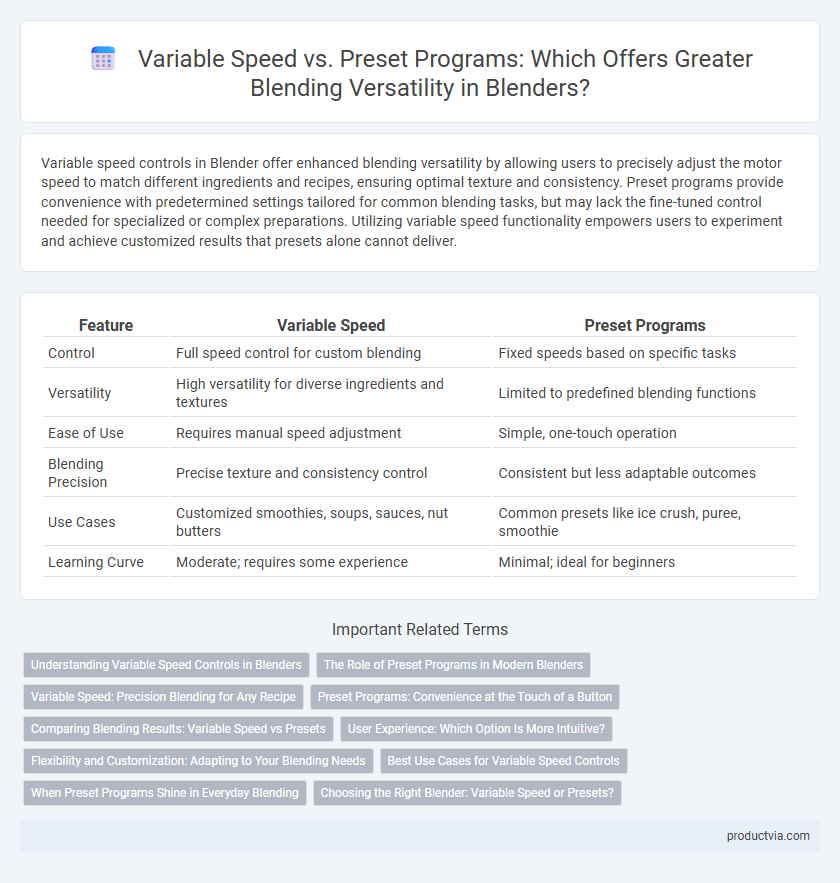Variable speed controls in Blender offer enhanced blending versatility by allowing users to precisely adjust the motor speed to match different ingredients and recipes, ensuring optimal texture and consistency. Preset programs provide convenience with predetermined settings tailored for common blending tasks, but may lack the fine-tuned control needed for specialized or complex preparations. Utilizing variable speed functionality empowers users to experiment and achieve customized results that presets alone cannot deliver.
Table of Comparison
| Feature | Variable Speed | Preset Programs |
|---|---|---|
| Control | Full speed control for custom blending | Fixed speeds based on specific tasks |
| Versatility | High versatility for diverse ingredients and textures | Limited to predefined blending functions |
| Ease of Use | Requires manual speed adjustment | Simple, one-touch operation |
| Blending Precision | Precise texture and consistency control | Consistent but less adaptable outcomes |
| Use Cases | Customized smoothies, soups, sauces, nut butters | Common presets like ice crush, puree, smoothie |
| Learning Curve | Moderate; requires some experience | Minimal; ideal for beginners |
Understanding Variable Speed Controls in Blenders
Variable speed controls in blenders provide precise manipulation over blending rates, allowing users to tailor texture and consistency to specific recipes or ingredients. This flexibility exceeds preset programs by enabling gradual speed adjustments, which prevent over-processing and accommodate delicate tasks like emulsifying or chopping. Understanding these controls enhances blending versatility, promoting customized results that preset settings often cannot achieve.
The Role of Preset Programs in Modern Blenders
Preset programs in modern blenders streamline the blending process by automatically adjusting speed, duration, and power to match specific tasks like smoothies, soups, or ice crushing. These programs enhance consistency and user convenience, reducing the need for manual speed adjustments while ensuring optimal texture and blending efficiency. Variable speed control remains essential for customization, but preset programs offer precise, repeatable results that appeal to both novices and culinary professionals.
Variable Speed: Precision Blending for Any Recipe
Variable speed control in Blender offers precise blending power that adapts to any recipe, enhancing texture and consistency with tailored speeds from gentle stirring to high-speed pulverizing. Unlike preset programs, variable speed allows users to manually adjust blending intensity, ensuring optimal results for diverse ingredients and customized culinary creations. This flexibility makes variable speed an essential feature for achieving professional-grade blending versatility in both simple and complex preparations.
Preset Programs: Convenience at the Touch of a Button
Preset programs in Blender offer unmatched convenience by automating blending cycles tailored for specific ingredients and textures, ensuring consistent results with minimal effort. These pre-configured settings optimize speed, time, and pulse actions, enhancing the appliance's versatility without requiring manual adjustments. Users benefit from efficient, repeatable blending processes, making meal preparation faster and more reliable.
Comparing Blending Results: Variable Speed vs Presets
Variable speed blending allows precise control over texture and consistency, adapting seamlessly to different ingredients for smoother or chunkier results. Preset programs offer convenience with predefined blending patterns optimized for common tasks but may lack customization for unique recipes. Comparing blending results, variable speed settings produce more tailored outcomes, while presets deliver consistent performance for standard blending needs.
User Experience: Which Option Is More Intuitive?
Variable speed blending in Blender offers users precise control over blending intensity, allowing for tailored texture and consistency adjustments that enhance creative flexibility. Preset programs simplify the user experience by providing ready-made blending modes, ideal for quick and consistent results without the need for manual adjustments. Users seeking intuitive operation often prefer presets for ease of use, while those requiring customization favor variable speed settings for a more hands-on approach.
Flexibility and Customization: Adapting to Your Blending Needs
Variable speed blending in Blender offers unmatched flexibility by allowing users to adjust motor power to handle diverse ingredients and textures, from delicate smoothies to tough nuts. Preset programs provide convenience with optimized speed and duration settings for common recipes but limit customization and real-time control. For blending versatility, variable speed models empower users to tailor the blending process precisely to their unique needs, enhancing both texture control and ingredient adaptability.
Best Use Cases for Variable Speed Controls
Variable speed controls in Blender offer precise blending versatility by allowing users to adjust motor speed to match specific ingredient textures, enabling smoother purees or chunkier mixes as needed. Best used for recipes requiring delicate control, such as emulsifying sauces or gradually thickening soups, variable speeds provide superior customization compared to preset programs. This flexibility enhances culinary outcomes and reduces the risk of over-processing ingredients.
When Preset Programs Shine in Everyday Blending
Preset programs in Blender streamline everyday blending tasks by offering tailored speed and texture settings optimized for common recipes, ensuring consistent results with minimal adjustment. Variable speed control, while flexible, requires more user input and experience to achieve similar outcomes, making presets ideal for quick and reliable blending. These preset programs excel in routine meal preparation where efficiency and ease are prioritized.
Choosing the Right Blender: Variable Speed or Presets?
Variable speed blenders provide precise control over blending power, making them ideal for recipes requiring gradual texture adjustments and delicate mixing. Preset programs offer convenience with automated cycles for common tasks like smoothies, ice crushing, or soup blending, saving time and reducing guesswork. Selecting between variable speed and preset blenders depends on the user's need for customization versus ease of use and the types of blending tasks most frequently performed.
Variable speed vs Preset programs for blending versatility Infographic

 productvia.com
productvia.com